2021 KTM 1290 Super Adventure R Review
Motorcycle Test by Vicko – Images by RbMotoLens & TH
So I managed to get the keys to the big Kato from Captain Hedge for a bit after it spent a week or two running around his local roads and being swapped between his good self and his partner in crime. I was pretty keen to ride it for both obvious and not so obvious reasons.
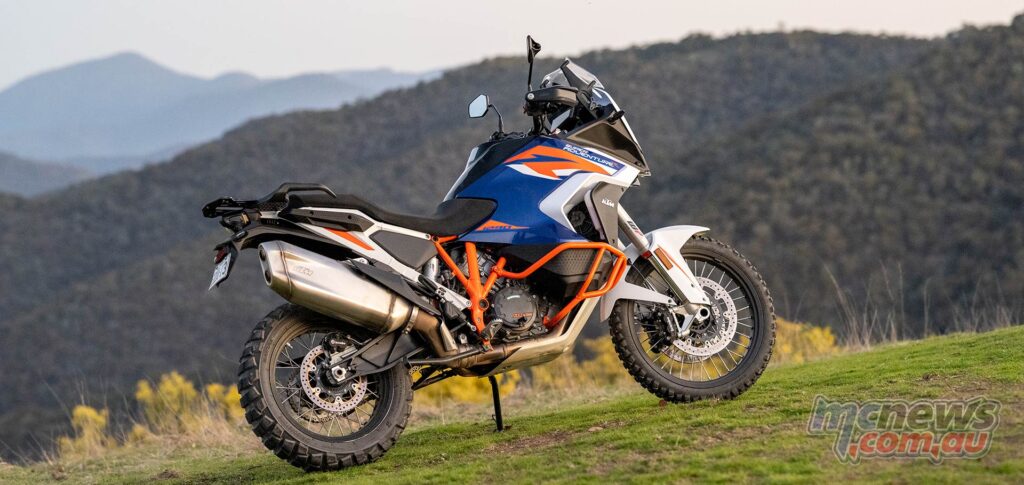
First the obvious. KTM don’t do half-arsed adventure bikes. Come to think of it, they don’t really do half arsed anything. And that LC8 1290 engine (which is actually 1301 cc) is close to perfection. It has me at hello in every guise that I’ve ridden on thus far. On top of that, the ‘middleweight’ 890 Adventure R that I rode on launch is arguably the best bike I’ve ever ridden. Not just the best Adventure bike. The best bike. Period. It’s brilliant and I want to have its babies. So if this has the same genes… it’s gotta be pretty good right?
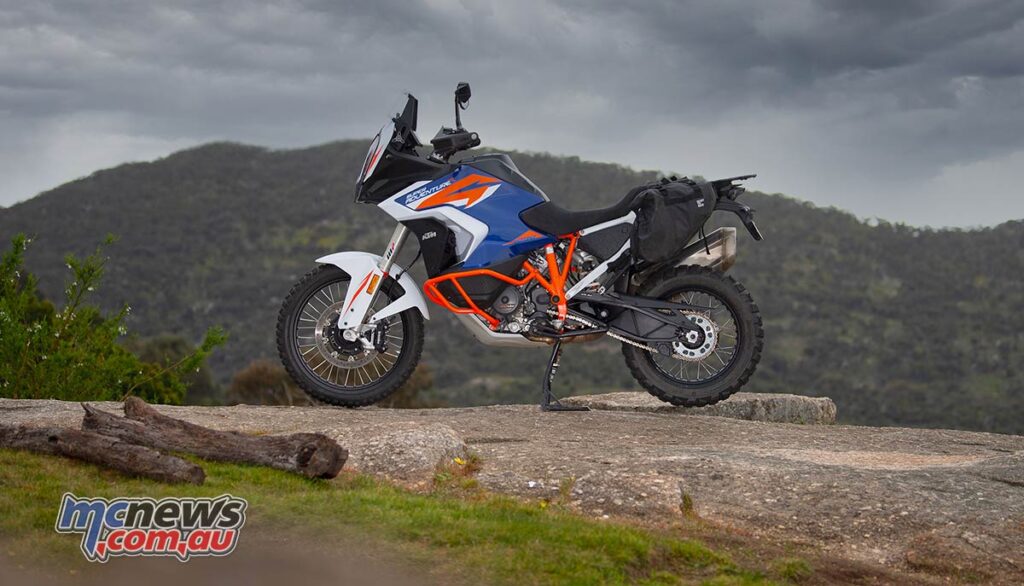
Now for the not so obvious. I’ve not yet had the pleasure of riding a big adventure bike in any really serious way off-road (Wayne’s version of serious differs to most others…) other than a stint on the Honda Africa Twin DCT (which I thought was quite good on the road, but still pretty big when the going got gnarly and it had road oriented dual purpose tyres on it). And I’ll be honest – I’ve never really felt the need or seen the attraction of the really big jiggers when compared to a middle-weight bike. Lots of extra size and weight and bulk for not much benefit as far as I could tell. Not for the sort of riding that excites me, which is probably a little more towards the more off-road end of the spectrum and involves jumps, whoops, sand, rocks, ruts, climbs and a bit of challenging stuff. So I wanted to get a proper feel for a full on, full fruit Adventure bike with aggressive tyres on it and see if my preconceived ideas of what it was capable was near truth, or complete bollocks. And in doing so, find out for myself where the compromise, if any, is to be made.
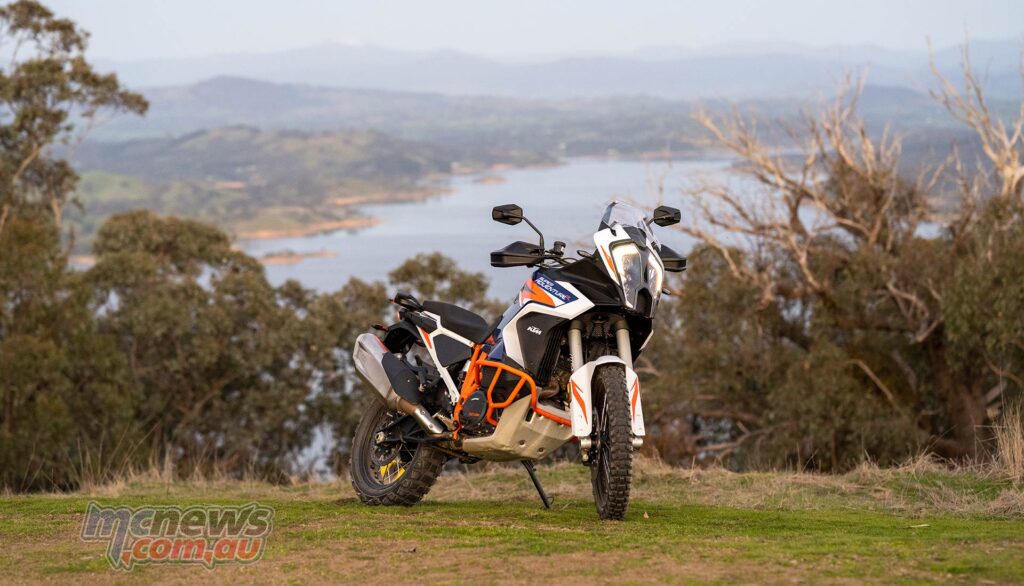
Now Trev has done a proper run down of most of the technical stuff here and I must say, it’s a tech tour de force. In fact, when I first jumped aboard it felt a little overwhelming stepping directly off my fairly simple old Tiger 800XC. Plenty of stuff going on on the dash and controls. Buttons by the dozen at your finger tips. I couldn’t help but think that the 890 was a little simpler and easier to be honest at first, but in no short time I found it hard to fault. I did notice later that the screen has quite a glossy finish to it. It didn’t ever pose an issue for me personally, but I do wonder if sun glare could be an issue at times.

Overall it really looks the biz. I dig the styling. Even the praying mantis style headlight assembly. I like what they’ve done with the radiator heat venting that directs the heat out and around the rider; And I prefer the more ‘tower’ oriented look that comes from having the headlight and screen unit connected to the side fairings on the 1290 compared to the 890 too. It just looks tough. They really should go that path with the 890…
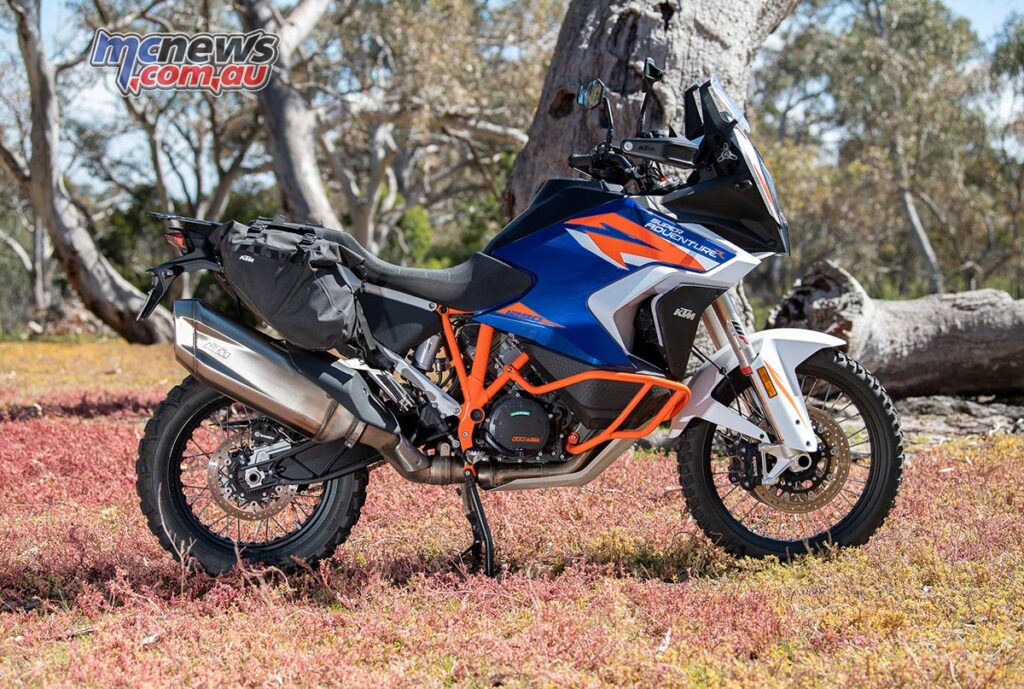
Street mode selected, I set off towards home. The first thing I noticed, was that the position of the gear lever was more inboard than I anticipated. It felt odd at first but I quickly got used to it. And then I gave it the old serpentine up the road.. holy hell it changes direction well. Really, really nicely. It just rolls over on its side effortlessly. Now my old Tiger 800 is pretty long in the tooth, nearing 300 thousand clicks under its belt, but I reckon the 1290 steers better than that does. Smooth, yet agile. Nicely weighted too. I’ve no doubt that the petrol tank design with all that mass down low helps. Also worth noting that the 1290 is ‘only’ 25 kegs heavier than the 890, tipping the scales at 221 kg dry.
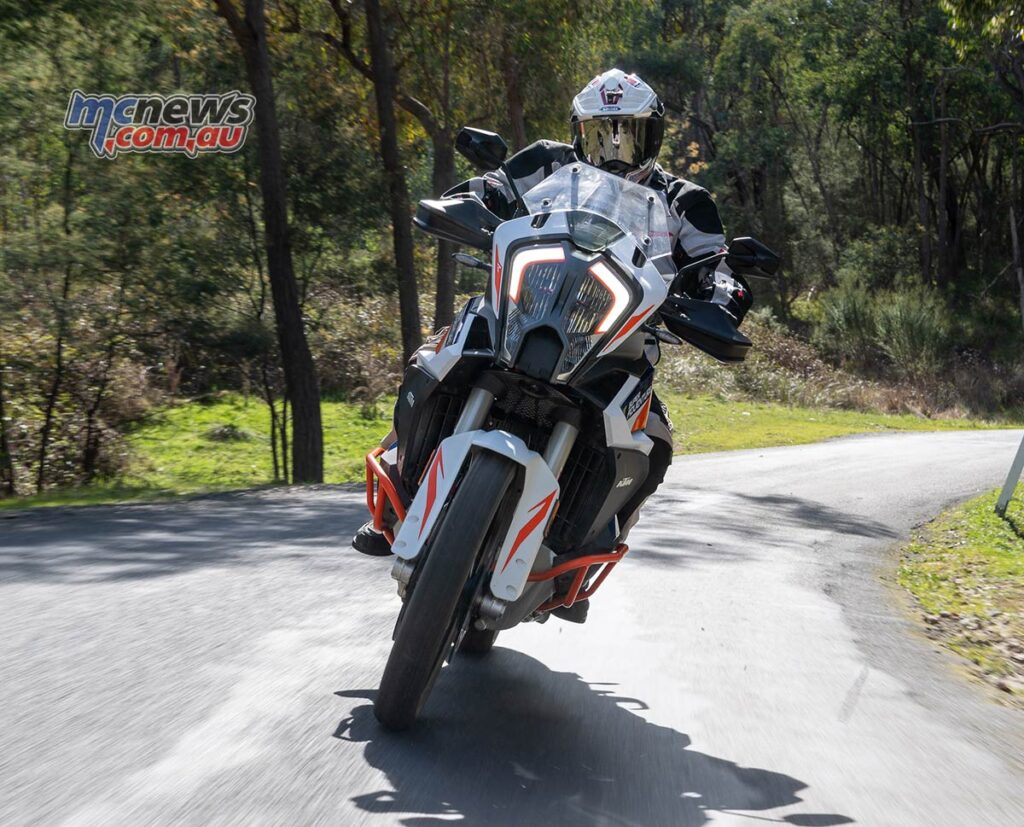
In fact, thinking about it now I’d say the low slung side petrol tank set-up is possibly an even better prospect on the big 1290 than its little brother. It comes with great crash bar protection, but I expect this bike is arguably less likely to tackle the really gnarly, rocky, higher risk stuff that the 890 would be. Unless your surname is Birch. Not that I’ve heard of any issues with the tanks being located where they are mind you. And once on board you forget all about it, but it is something you think about when you’re looking at the bike and pondering such things.
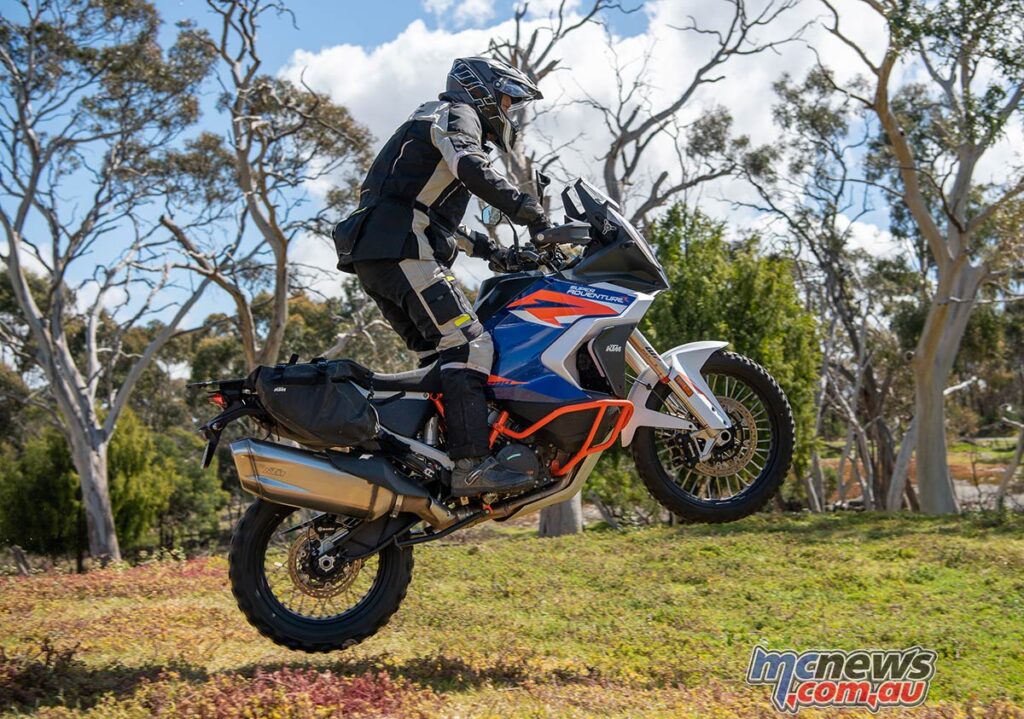
So it turns out that it’s far more capable overall on tarmac than it should be for a bike of this bulk. Even though I was trying to be a little sensitive to the Bridgestone Battlax AX41 knobbies, it proper hauls on tarmac. I mean with 160 hp and nearly 140 Nm of torque it shouldn’t come as a surprise, but I’d imagine with some more road oriented rubber you’d be able to hold your own with nearly anything. Especially on an average Aussie road that isn’t billiard table smooth.
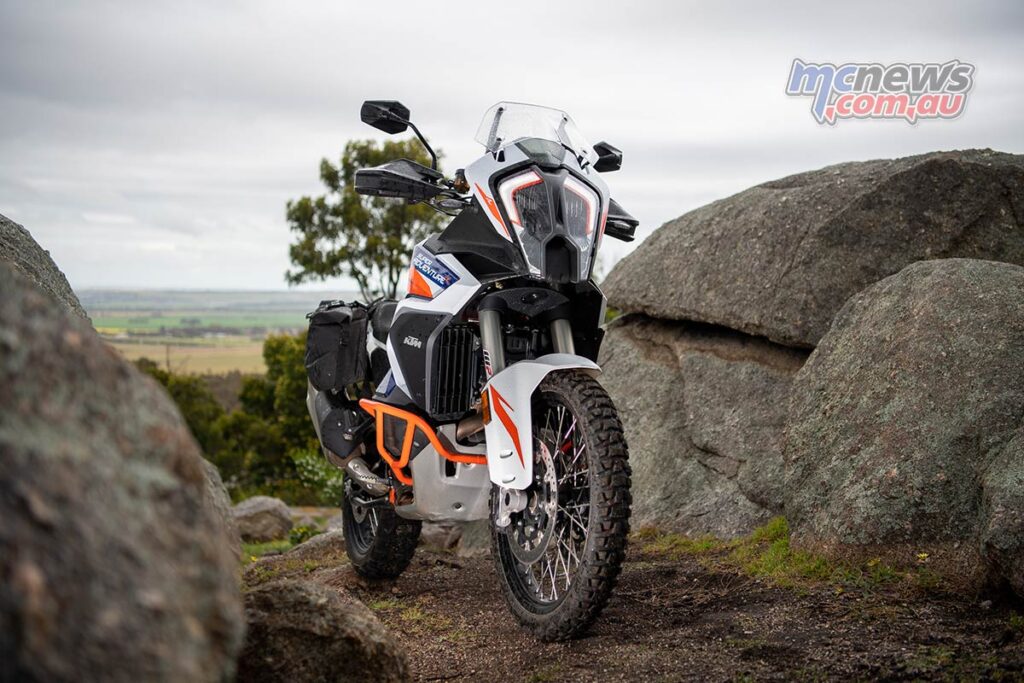
Coasting along the exhaust note seems perhaps overly muted to my ears and the quick-shifter took a few minutes to gel with – could be a case of working better when up to temp? I’m also conscious that I was shifting up too early in the first few minutes. It just lugs from so low that you don’t realise you’re barely off idle at times. After a couple of kays though and with me getting more familiar with it, it wasn’t an issue at all. And together with the excellent slipper clutch, shuffling cogs requires little effort or thought.
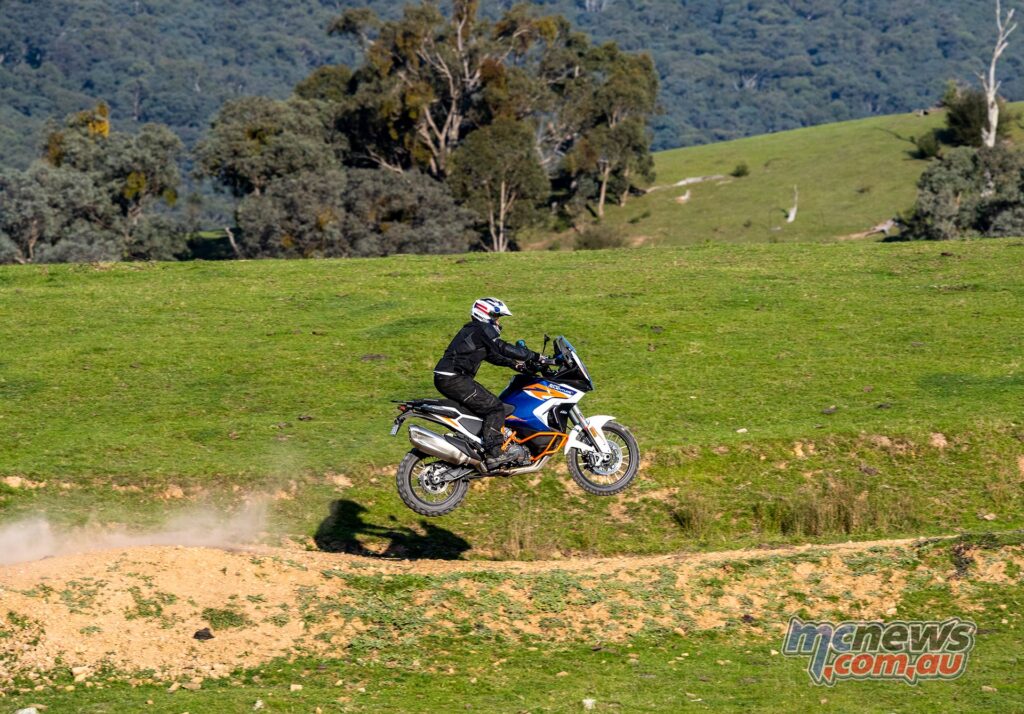
The engine shouldn’t need talking about. It absolutely, positively rocks. It’s silky smooth off idle, but has some almighty poke only a moment away when you want it. Glorious. Street mode v Sport mode has a slight but noticeable difference – I’d suggest prospective owners have a good play and understand what does what and what they prefer. Everything is as you’d expect, the only callout being that Rally mode has a simpler dash display which includes the TC setting (I preferred the Rally design to be honest). In fact, much like the 890… I’d probably just leave it in Rally mode with street throttle most of the time, and dial the TC up or down as I wanted it.
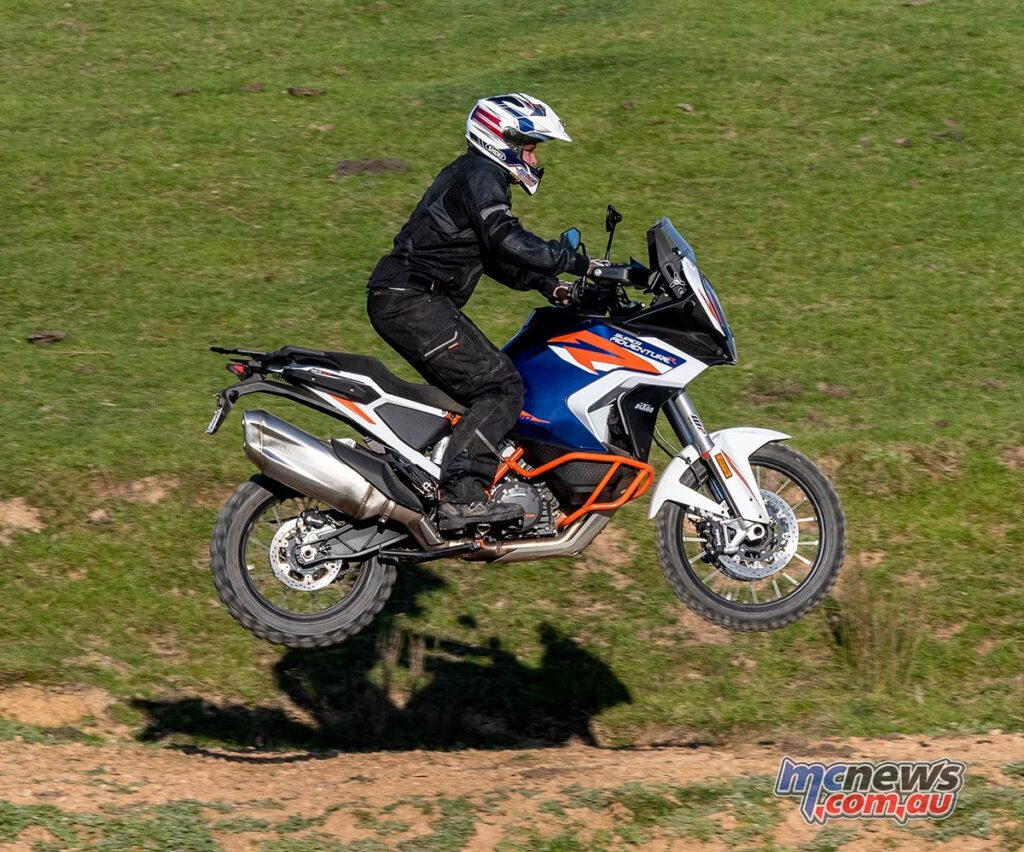
The only other mode I’d ever use would be sport if I was carving some tarmac on it and when in Sport mode I’d switch to Sport throttle. Does it really need all the other modes then if you have such a good TC system that’s adjustable on the fly in Rally mode? I’d suggest not, but I like simple. I mean why do I need a rain mode when you have such good TC? No. No I don’t.
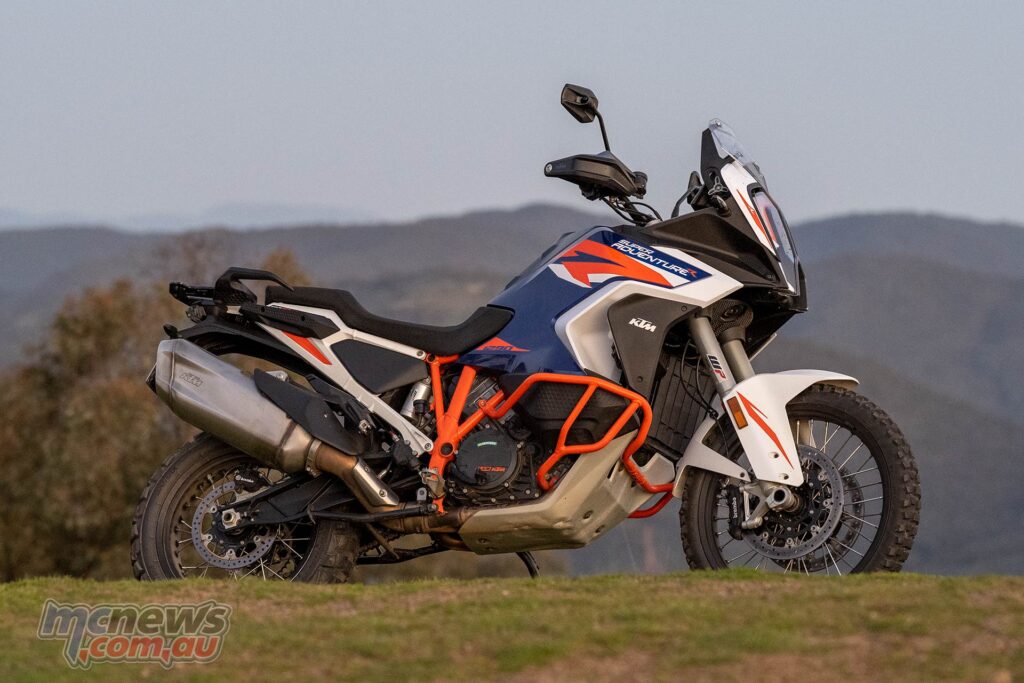
Note that off-road and wet modes drop the power output back to around 100 hp, but Street, Sport and Rally give you the full 160 hp welly. Having said all of that, the Rally mode is an optional extra… One that I think probably should be standard. But we’ll come back to that.
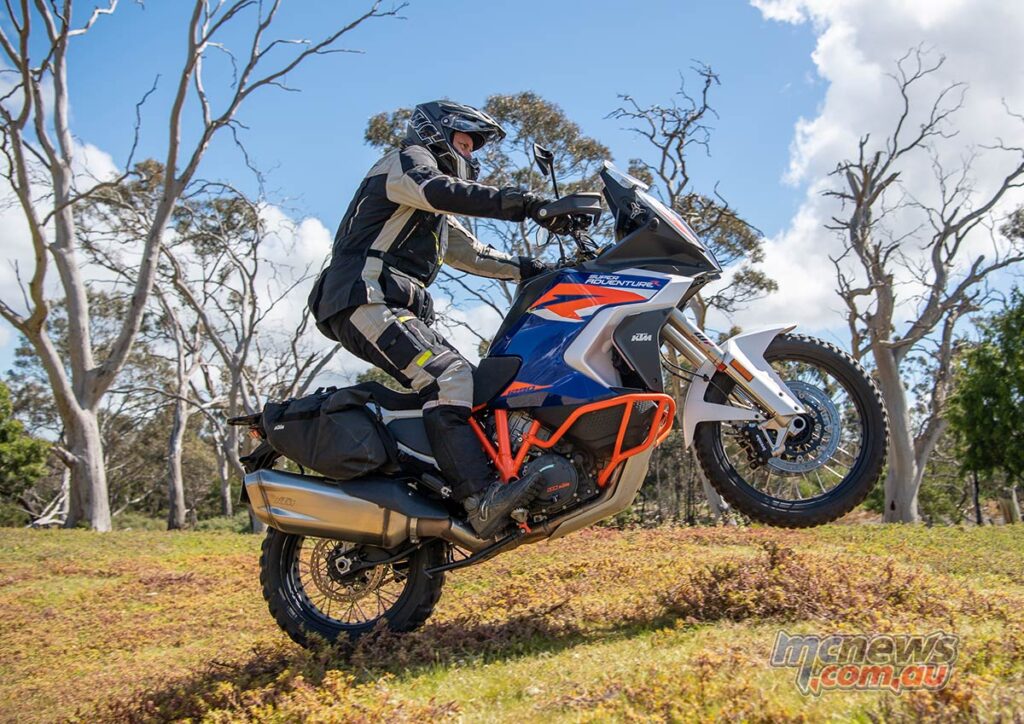
So I get home, spend some time admiring it some more and then 15 minutes I’m back out there hitting my local trails charging at a reasonable pace. The overwhelming impression is of its ability to just pile on speed when you decide to get up it. It doesn’t really matter what gear you’re in, a twist of that throttle sees you propelled forward at serious rates when you want it. It’s monumentally effective. It actually takes a little to get used to because it’s so effortlessly deceptive that some self control is required. That LC8 lump never seems to be working particularly hard. Even when you think you’re having half a go you can twist a bit more and it dials up the growl and propels you harder again towards the next corner. Ohhh mummy… Skids for days. It is a BEAST.
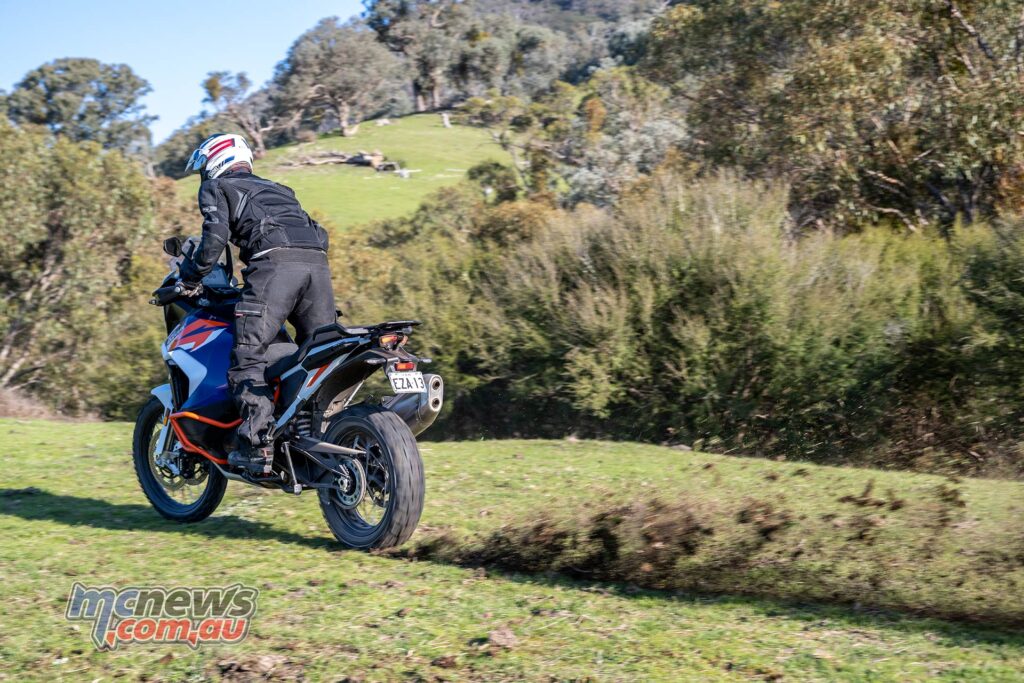
And it has such a great throttle. Fuelling is bang on, the quick-shifter is a delight once you get dialled in, it gels in a way that you quickly forget everything other than choosing your lines and deciding how brave you want to be with the throttle and braking…
That’s when the aforementioned self control needs to kick in. You see because it’s so unexpectedly agile, you can easily forget that you need to pull up just under 240 odd kilos (with fluids) before the next turn… There’s nothing wrong with the brakes at all, in fact the 320 mm dual piston radial caliper Brembos up front and 267 mm twin piston at the rear are tremendous, have plenty of feel and properly good stopping power. But you can’t beat physics. Big bikes at big speeds take some pulling up on dirt.
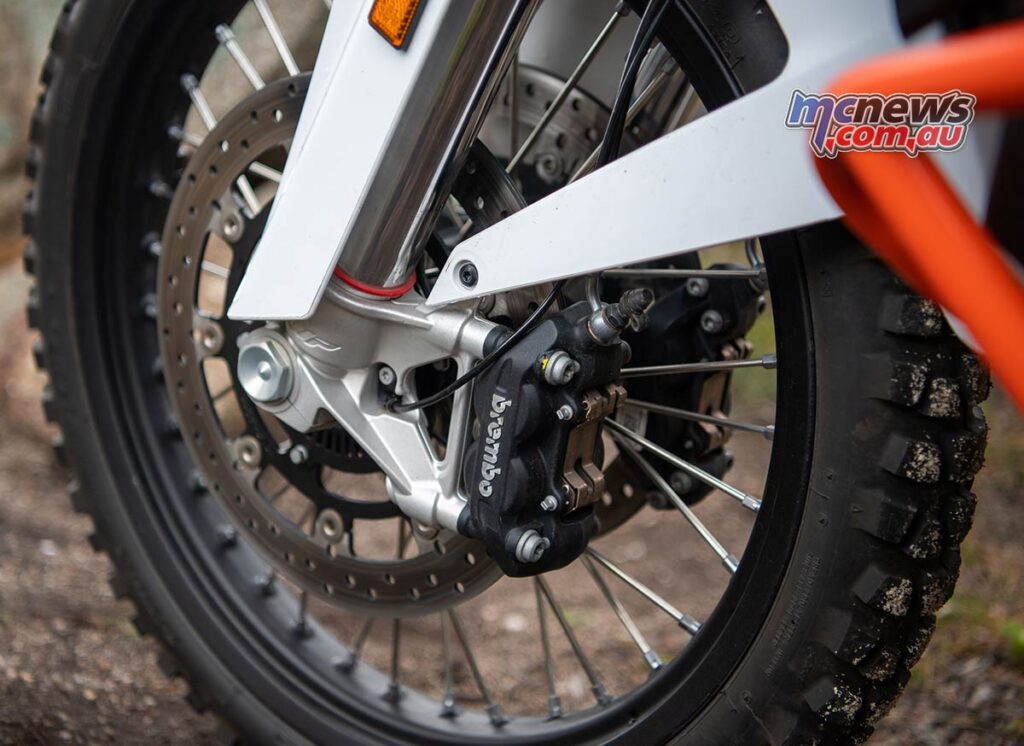
Suspension wise – it’s not quite the out of the box capable jumper that the 890 Adventure R is, the first big erosion mound I hit at speed I did juuuuust bottom out, but after dialling up a little more each of comp and rebound I found the WP Xplor forks with 220 mm of travel to be pretty bloody impressive. I didn’t even have to touch the matched rear shock at all as it was close enough to perfect on standard settings.
My standard test loop involves some good sand sections, some rutted descents and climbs, rocks, whoops. It’s a nicely varied loop and the big 1290 managed it all in its stride. It positively flew up a particularly steep rocky climb that can sometimes be a handful.
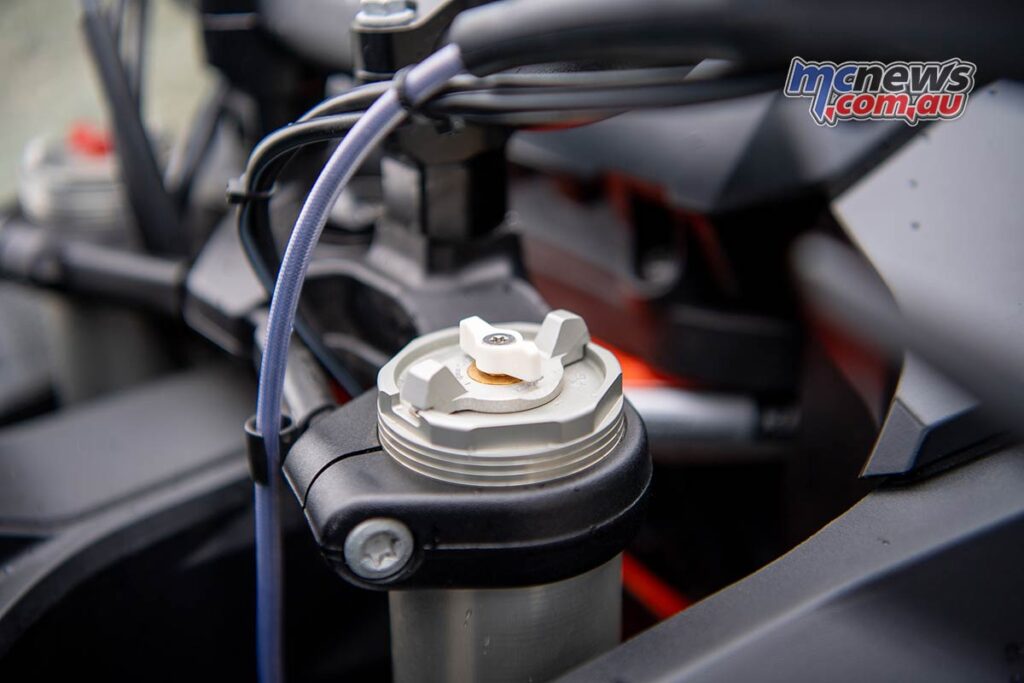
Only once did I have to stop and manhandle the bike on one particular downhill section of single track where I – you guessed it – found myself coming in a little hot and got off line. And that’s really the only time I felt the size and bulk of the bike. When trying to man-handle it and manoeuvre it back into a position I needed it to be. You simply can’t man-handle big adventure bikes of this size – you have to let the engine do the work for you. Once I recalibrated the brain to accept that and formulated a new plan, I was good to go. But that’s a telling factor in terms of the type of riding I’d be comfortable doing regularly – and solo – on the big beast.
It’s pretty comfortable too. The whole seat and ergos are a nice place to be both sitting and standing, with an 880 mm seat height that actually feels lower than the number suggests. One of the many updates from the previous model is that the seat is slightly lower and narrower to help usability. It’s not a tip toe proposition to get your boots down at all. Good wind protection too, with an easily adjustable screen that works well to deflect wind while still being low enough to not be in the way. All in all a pleasant place to be.
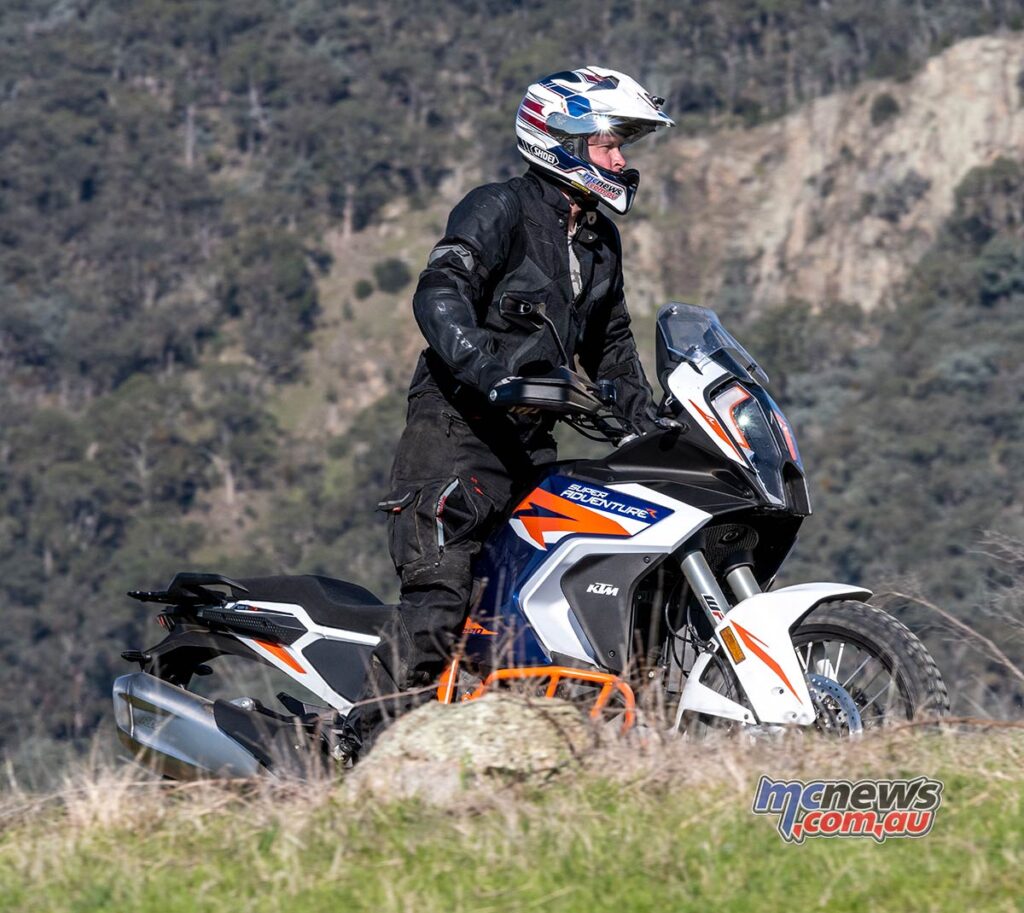
It comes with excellent pillion accomodation and ample tie down points for soft bags and kit. Speaking of soft bags – the ones shown in the pics are KTMs new soft panniers. I found them to be damn good. Plenty of volume (12 litres each side), I had them stuffed with a hiking tent and sleeping bag, a pair of jeans and three jumpers to get them packed out and there was still heaps of room left.
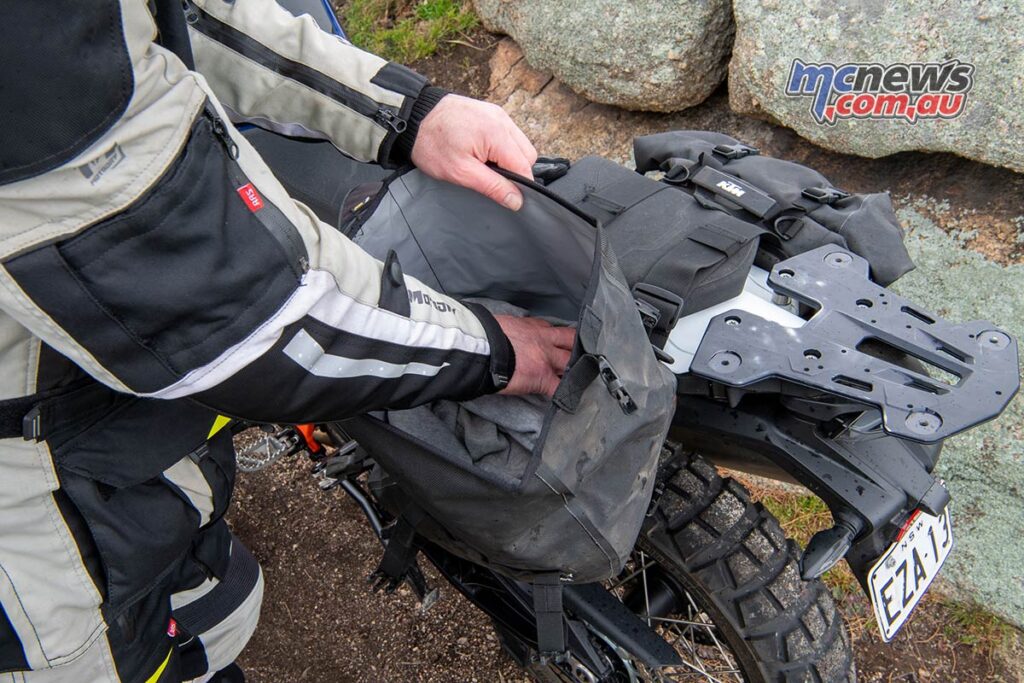
They have a simple roll top opening and side clips, followed by two clipped straps across the top to keep it snug. Simple, light, easily detachable from the bike too. They’re a $470 power part option well worth considering.
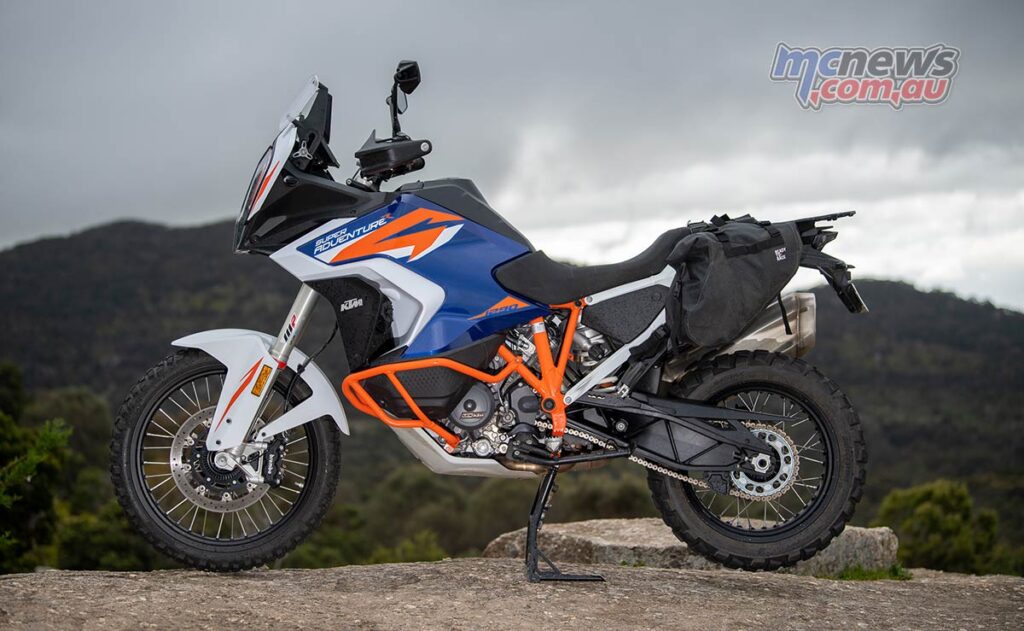
You just can’t go past the engine though. Any gear, any speed, the 1290 will light up the rear on gravel if you want it too. It’s bonkers. Absurdly fun and proper quick. Ludicrous slides are around every corner as it’s so well balanced it flatters the rider and encourages you to explore your limits and pretend you’re Chris Birch. If saying no to slow is your thing… the orange crew have a bike waiting for you. Just be warned, I reckon I’d want a steady stream of rear tyres lined up because it’s damn addictive. I found that running the TC at around 3 or 4 seemed pretty much bang on for most of the time. Enough slip to get some proper slides going on and steer with the rear when I wanted, with the knowledge that if my ambitions got ahead of my talent, there was a safety net in place. Noice. And then a few quick taps to bang the TC down to 0 if I want to pull some minger wheelies. (The TC is controlled by the cruise control + and – buttons on the left cluster).
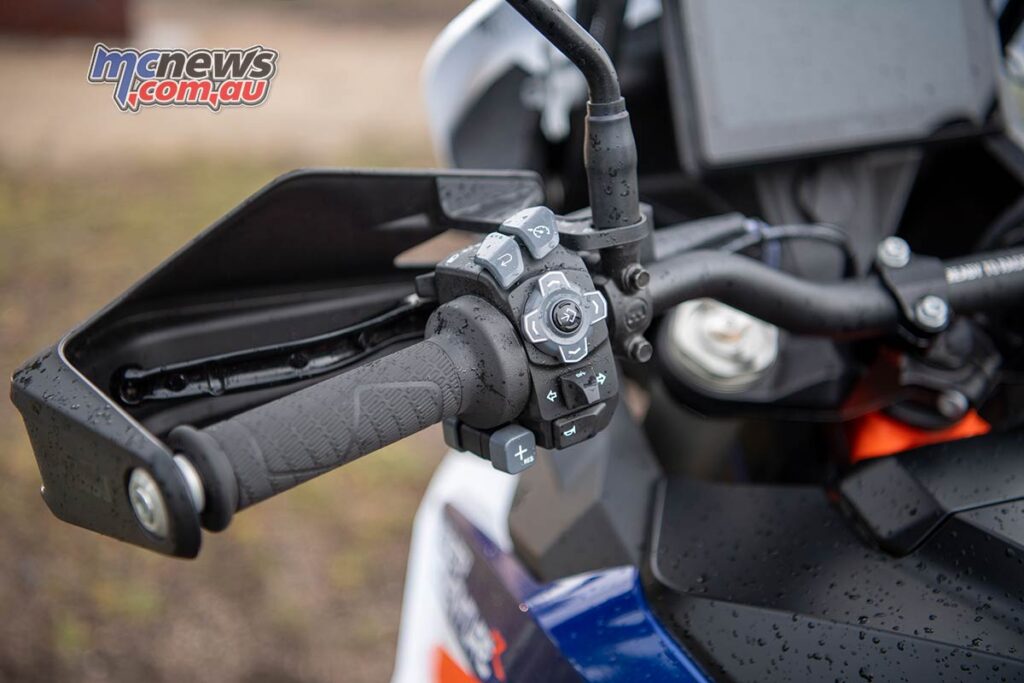
The fact that this bike can absolutely rip, which it can, while also having such good low speed stability and rideability is spooky. It’s actually that very rideability that brings out the hooligan in you. It really is a monster with nice table manners.
In the end I can absolutely see the appeal. If you want to properly get out of Dodge and tackle some remote gravel roads and bush tracks, cut loose up some fire trails, take the missus away for the weekend, frighten some sportsbike riders, or commute to work. Or a mix of all of the above? The 23 L tank will certainly get you there and back. That’s a comfortable 450 km range.
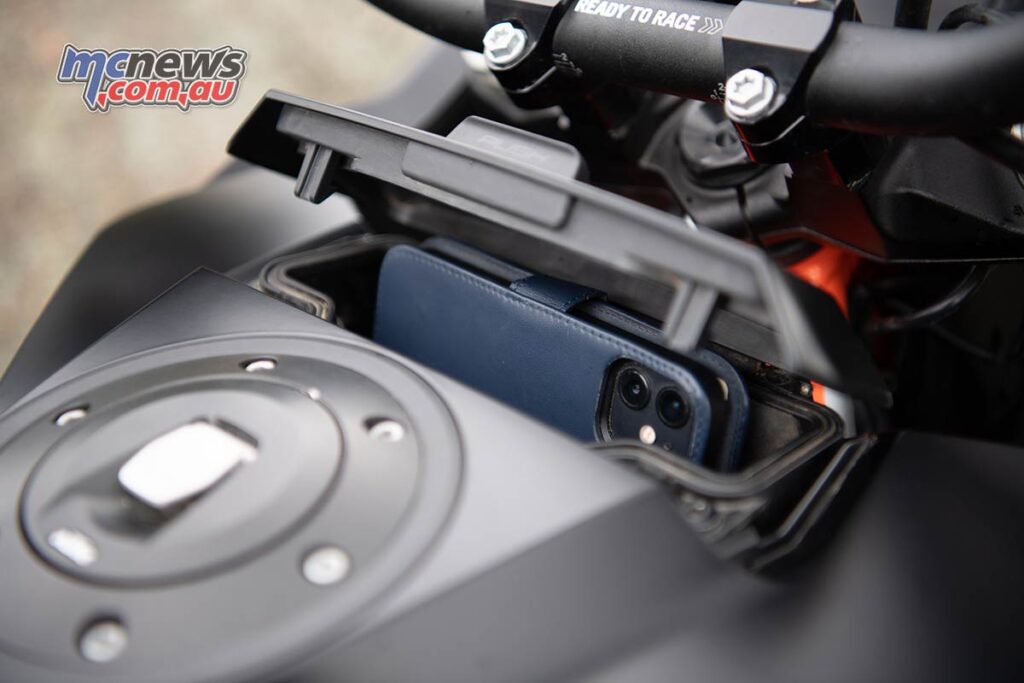
As a ‘one bike to do it all’ offering, it’s bloody impressive. It’s not going to be as easy a proposition on the more technical stuff that the smaller 890 can handle with ease. But I reckon if you approach it more from a ‘what can I ride confidently where I know I won’t have a problem if I have to stop mid obstacle’, you’re probably on the right track as to where this bike will shine. And if you wanted to do more technical, snotty stuff, you’d have an EXC300 two banger or EXC350 parked up next to it in the shed anyway. Because, physics is physics; And sadly we’re not all freakishly talented like Chris Birch, as much as we’d like to be.
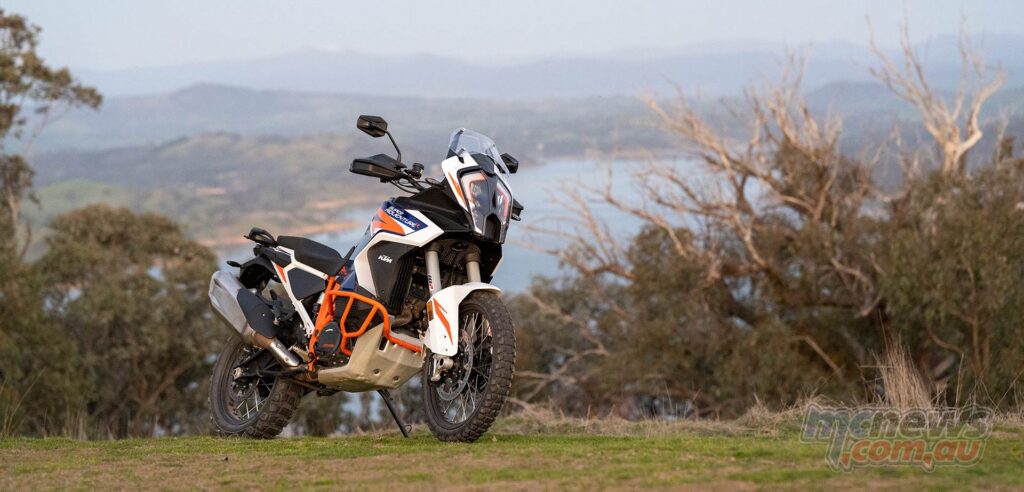
The Rally mode is a must as far as I’m concerned. I raved about it in the 890 and for good reason. It’s faultless, intuitive, adjustable on the fly without the need to close the throttle. Perfect, perfect, perfect. The only not so perfect part of it is that it only comes as part of the ‘RALLY’ tech pack worth an additional $1,259.00. That tech pack also includes the Quickshifter+, MSR (Motor Slip Regulation), HHC (Hill Hold Control) and an Adaptive brake light. So added to the recommended ride away price of $32,130 that puts it at $33,389 dollaridoos. It ain’t cheap. But good stuff never is. And it’s definitely good stuff.
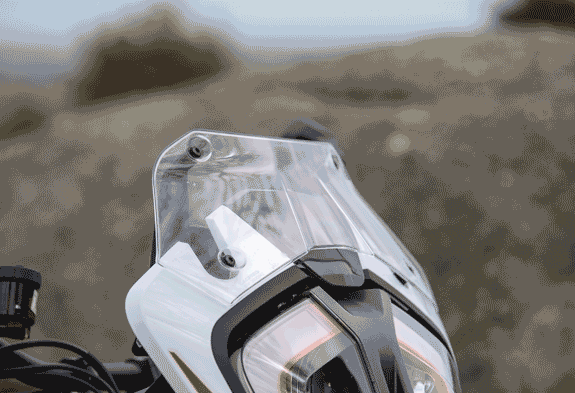
So – in the end, did I get an answer for my own question? How does it compare to it’s little brother – the middle-weight ‘off-road’ focussed Adventure benchmark that is the 890 Adventure R? Well it comes with pretty much all the same tech so I won’t go over all of that again other than to say it’s mega in both applications. No surprises that it’s physically bigger in every way than the 890 – roomier and more comfortable. There’s boat loads of room for yourself, gear and/or a pillion. But what is surprising is the agility and rideability.
The downside? While it’s ‘only’ 25 kilos heavier, that’s still a noticeable difference. That said – although it might be about 12 per cent up on weight, it boasts a bump of over 50 per cent in power (160 hp vs 105). So if you rate big power and mile eating comfort with the option to dial up hooligan levels of fun at the expense of a little agility and off-road capability – this could very well be up your alley. It really depends on what type of riding you want to do.
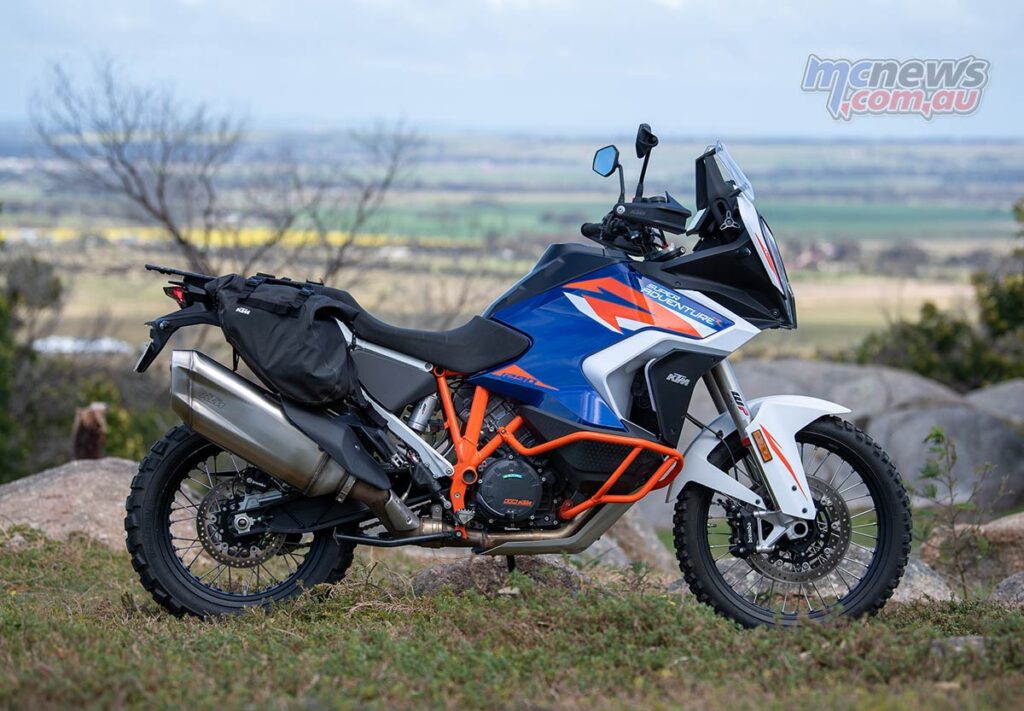
If I could only have one bike in my shed I’d personally take the 890. It’s the sensible choice for my type of riding bearing in mind that I don’t do pillions. That said, I don’t always make sensible choices. In fact some of the best times I’ve had riding have come from decidedly insensible decisions. And if I had two bikes in my shed, which I do… I’d have a lightweight enduro, which I do… and… oooh… decisions, decisions. They say power corrupts don’t they?
I think maybe I should hang onto it for a bit longer just to be sure…
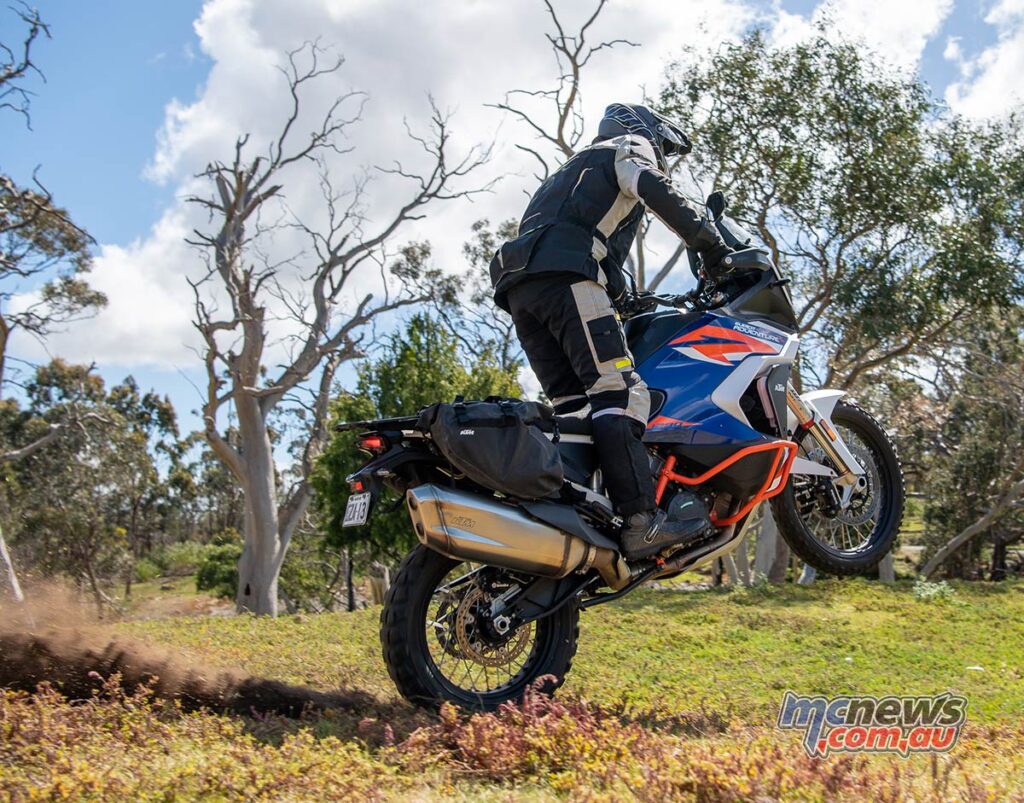
Why I like the KTM 1290 Super Adventure R
- It’s a 160hp adventure-sports bike. What’s not to like?
- The skids
- It can be other-worldly rapid when you want it to
- Oh my god the skids
- But yet somehow smooth, agile and easy to ride?
- The same awesome tech wizardry in the Rally pack that the 890 gets
I’d like it more if
- Rally pack probably should come as standard at that price
- And so should heated grips. Why no heated grips KTM?
2021 KTM 1290 Super Adventure R Specifications
| 2021 KTM 1290 Super Adventure R Specifications | |
| Engine | 1,301 cc, two-cylinder, four-stroke, V 75°, four valves per cylinder / DOHC |
| Bore x Stroke | 108 x 71 mm |
| Compression Ratio | 13.1:1 |
| Claimed Power | 118 kW (160 hp) @ 9,000 rpm |
| Claimed Torque | 138 Nm @ 6,500 rpm |
| Induction | Keihin EFI (throttle body Ø 52 mm) |
| Gears | Six gears |
| Clutch | PASC slipper clutch, hydraulically operated |
| Frame | Chromium-Molybdenum-Steel trellis frame, powder coated, Aluminium, powder coated sub-frame |
| Forks | WP XPLOR Upside-Down Ø 48 mm, Compression, rebound, preload adjustment, 220 mm travel |
| Shock | WP XPLOR shock absorber with PDS, Compression (high and low speed), rebound, hydraulic preload adjustment, 220 mm travel |
| Wheels & Tyres | Forged aluminium rims with spokes 2,5 × 21″ ; 4,25 × 18″, 90/90 21; 150/70 ZR 18 (OT Version: 90/90 × 21; 150/70 × 18) |
| Front Brakes | Dual Brembo four-piston, radially mounted caliper, brake discs Ø 320 mm |
| Rear Brake | Brembo two-piston, fixed caliper, brake disc Ø 267 mm |
| Electronics | Bosch 10.3ME Combined-ABS (incl. Cornering-ABS and offroad mode, disenengageable), Keihin EMS with RBW and ACC (adaptive cruise control), double ignition, MTC (lean-angle sensitive, 4 modes, disengageable), Rally Mode |
| Instrumentation | 7″ TFT |
| Dry Weight | 221 kg |
| Ground Clearance | 242 mm |
| Seat Height | 880 mm |
| Wheelbase | 1,577±15 mm |
| Rake / Trail | 64.7° / 112.8 mm |
| Fuel Capacity | 23 litres / 5 l reserve |
| Service Intervals | 15,000 km |
| Warranty | 24-month |
| Available | May, 2021 (Australia) |
| Price | $32,130 Ride Away |

